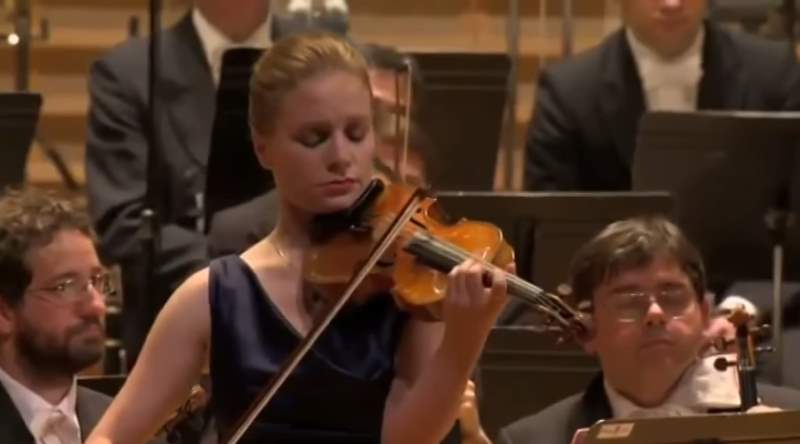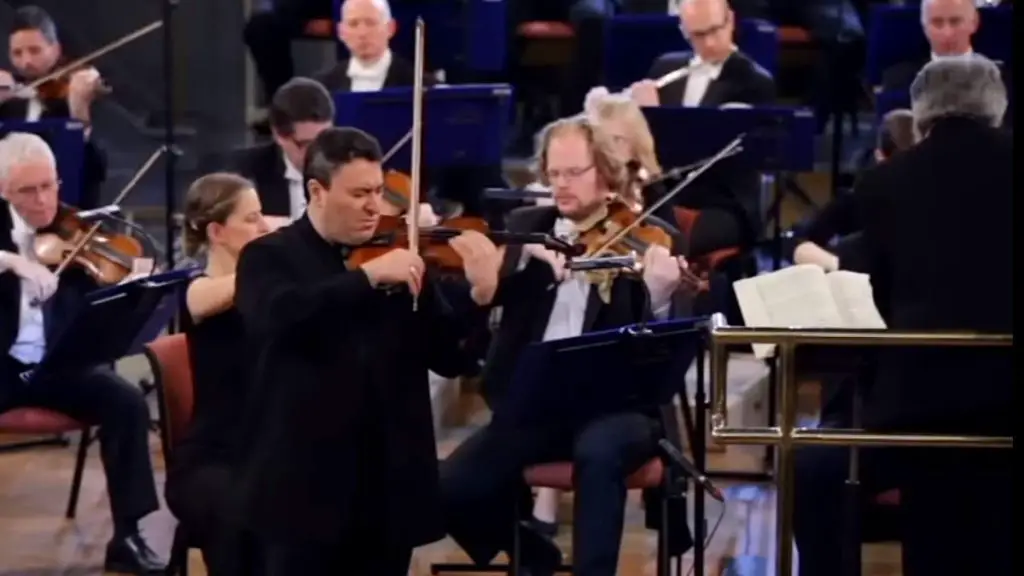Accompanied by the Saint Petersburg Philharmonic Orchestra, Soviet-born Israeli classical violinist Maxim Vengerov performs Pyotr Ilyich Tchaikovsky’s Violin Concerto in D major, Op. 35. Conductor: Yuri Temirkanov. Recorded in Tokyo, Japan on June 30, 1993.
Tchaikovsky’s Violin Concerto in D major, Op. 35
Composed in 1878, Pyotr Ilyich Tchaikovsky’s Violin Concerto is one of the most popular and frequently performed violin concertos in the world. The piece was composed for the famous Hungarian violinist Leopold Auer (1845-1930), but Auer refused to perform it, citing its technical difficulty. He also felt that “some of the passages were not suited to the character of the instrument, and that, however perfectly rendered, they would not sound as well as the composer had imagined”.
However, the work was premiered in Vienna on December 4, 1881, by the young Russian violinist Adolph Brodsky (1851-1929) on December 4, 1881, in Vienna, under the baton of Hans Richter, to great acclaim. Since then, the Tchaikovsky Violin Concerto has become a staple of the violin repertoire and is considered one of the most challenging and demanding concertos for the instrument.
The concerto is known for its sweeping melodies, virtuosic violin passages, and lush orchestration. It requires the soloist to have advanced technical skills and a deep understanding of musical expression. The Tchaikovsky Violin Concerto is a beloved work that has been recorded and performed by many great violinists, including Itzhak Perlman, Janine Jansen, and David Oistrakh.
Movements
1. Allegro moderato (D major)
The first movement of Tchaikovsky’s Violin Concerto in D major, Op. 35, is a masterpiece of the violin repertoire, celebrated for its emotional depth, technical challenges, and captivating melodies. Marked Allegro moderato, it is a vibrant and dynamic opening to the concerto, setting a tone of grandeur and passion.
The movement begins with a bold orchestral introduction, laying a rich foundation of sound that immediately draws the listener into the piece. This introduction foreshadows the grandeur to come, creating a sense of anticipation. When the solo violin enters, it does so with a virtuosic cadenza, a dazzling display of technical brilliance that challenges even the most skilled performers. This passage highlights the soloist’s ability to execute rapid scales, arpeggios, and intricate bowing techniques, serving as a dramatic gateway to the movement’s main theme.
The main theme, a soaring and lyrical melody, is one of Tchaikovsky’s most memorable creations. It is carried by the violin, which sings above the orchestra’s lush and dynamic accompaniment. Tchaikovsky’s use of harmony and orchestration here is masterful, creating a rich tapestry of sound that complements the violin without overpowering it.
As the movement progresses, Tchaikovsky explores a variety of musical ideas, seamlessly blending virtuosity with deep emotional expression. The solo violin is often given extended passages of dazzling technical complexity, including double stops, rapid runs, and challenging leaps, all of which require exceptional dexterity and control. Yet, it is not just a technical showcase; the music is infused with passion, drama, and a sense of longing that gives it its emotional resonance.
The first movement culminates in a thrilling climax, with the orchestra and soloist building to a powerful and triumphant restatement of the main theme, bringing the movement to a rousing and dramatic close. It is a breathtaking start to one of the most beloved violin concertos in the classical repertoire.
2. Canzonetta: Andante (G minor)
The second movement of Tchaikovsky’s Violin Concerto, marked Canzonetta: Andante and written in G minor, is a poignant and introspective interlude between the fiery first and third movements. This movement serves as a moment of lyrical reflection, offering a stark yet beautiful contrast to the surrounding dramatic sections of the concerto.
The movement opens with a gentle, plaintive solo violin melody, accompanied by a subtle pizzicato rhythm in the orchestra. This understated beginning sets a contemplative and melancholic mood, drawing the listener into the music’s intimate emotional landscape. The solo violin quickly takes center stage, weaving a melody that is both tender and expressive, revealing Tchaikovsky’s gift for crafting melodies that speak directly to the heart.
As the movement progresses, the violin’s lines become more emotive and nuanced, requiring the soloist to demonstrate a deep understanding of phrasing and expression. The accompaniment by muted strings creates a soft, supportive texture, allowing the solo violin to shine while maintaining an atmosphere of restraint and delicacy. The interplay between the violin and orchestra is subtle and harmonious, emphasizing the movement’s lyrical and introspective qualities.
Tchaikovsky’s Canzonetta is a masterclass in evoking emotion through simplicity. The melodies, while not overly elaborate, are imbued with a profound sense of yearning and introspection. The movement requires exceptional sensitivity and finesse from the soloist, as the emotional weight lies as much in the phrasing and tone as in the notes themselves.
The Canzonetta concludes softly, with the violin’s final notes fading gently, almost as if sighing into silence. This delicate ending seamlessly transitions into the energetic opening of the third movement, providing a striking contrast. The second movement stands out for its lyrical beauty and emotional depth, offering a tender reprieve in a concerto renowned for its virtuosic brilliance.
3. Finale: Allegro vivacissimo (D major)
The third movement of Tchaikovsky’s Violin Concerto, Finale: Allegro vivacissimo, written in D major, is a triumphant and exuberant conclusion to this iconic work. Bursting with energy, the finale is a lively dance that not only dazzles audiences but also pushes the soloist’s technical abilities to their limits.
The movement begins with a brief, spirited orchestral introduction that sets the stage for the soloist’s entrance. The violin quickly joins with a rapid, technically demanding passage, immediately establishing the fiery and playful character of the movement. Shortly after, the main theme is introduced: a fast-paced, dance-like melody driven by an insistent rhythm in the orchestra. This theme is full of vitality and joy, embodying the celebratory nature of the finale.
Throughout the movement, Tchaikovsky masterfully combines virtuosic displays with engaging musicality. The soloist is tasked with executing blisteringly fast runs, intricate arpeggios, and dazzling double stops, all while maintaining the playful and spirited tone of the music. The orchestra complements the violin with rich harmonies and vibrant rhythmic accompaniment, creating a dynamic interplay between soloist and ensemble.
One of the movement’s standout features is the spirited call-and-response exchanges between the violin and the orchestra. This dialogue is marked by an infectious energy, as if the two are engaged in a lively musical conversation. Tchaikovsky also weaves in dance-like motifs and syncopated rhythms that evoke a sense of folk-inspired celebration, a nod to his admiration for Russian and Eastern European folk music.
The Finale culminates in a breathtaking climax, with the soloist and orchestra building to an exhilarating conclusion. The rapid-fire passages and triumphant restatements of the main theme leave the audience on the edge of their seats. It’s a thrilling end to a concerto renowned for its emotional depth, technical brilliance, and breathtaking artistry, ensuring that the listener is left both exhilarated and awestruck.
Sources
- Violin Concerto (Tchaikovsky) on Wikipedia
- “Deep Listen: Tchaikovsky Violin Concerto in D major” on the ABC Classic website
- “Tchaikovsky – Violin Concerto in D” on the Classic FM website
- “Great Escape: Tchaikovsky’s Violin Concerto” on the Houston Symphony Orchestra’s website
- Why Is Tchaikovsky’s Violin Concerto So Irresistible? on WRTI.org
- “The Story Behind Tchaikovsky’s Violin Concerto” on the Rhode Island Philharmonic Orchestra & Music School’s website
- Violin Concerto, Op. 35 (Tchaikovsky, Pyotr) on the International Music Score Library Project website


